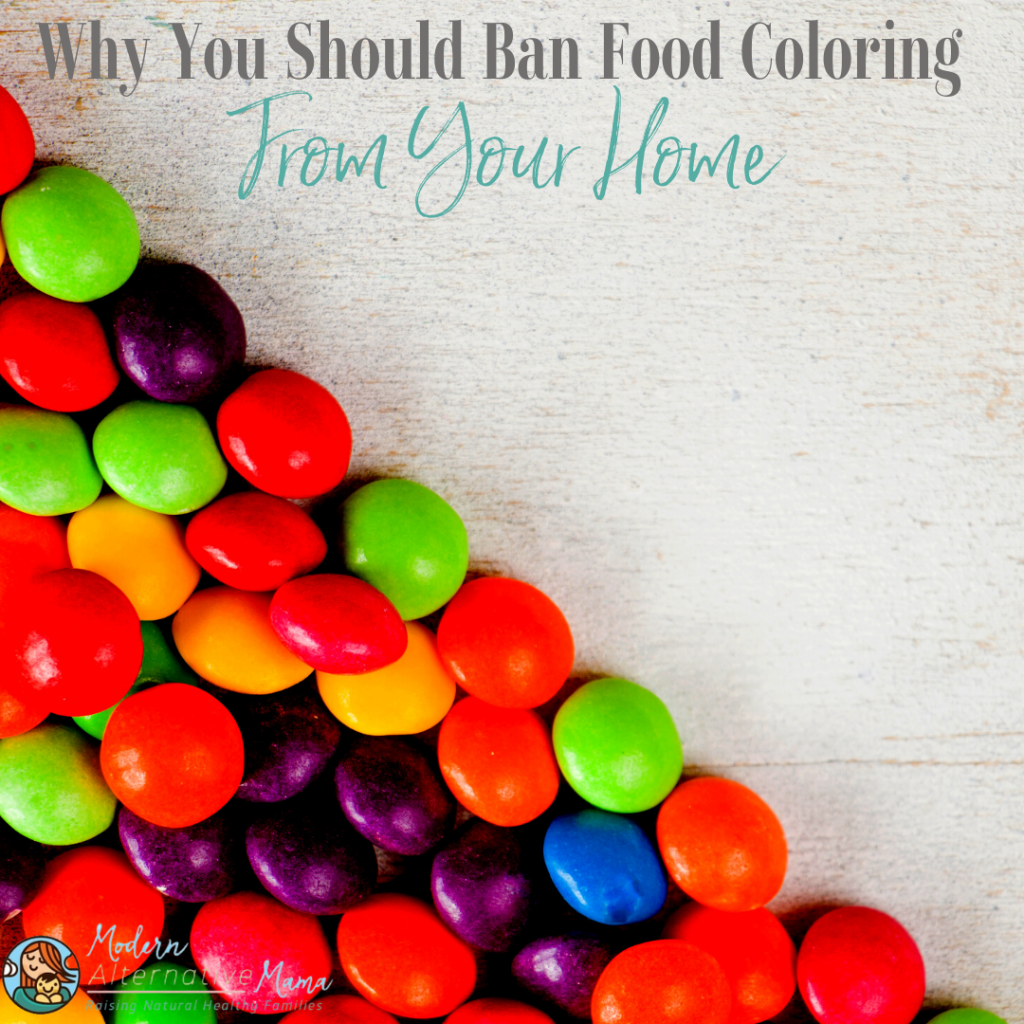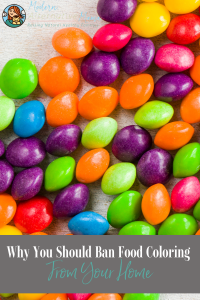With Americans eating five times as much food dye as we did in 1955, we thought this was an important topic to cover. Over 15 million pounds of food dye are used annually in the U.S., even though their safety is questioned (1).
Food dyes are made from petroleum products. Research has associated food dyes with many medical conditions. Food dye consumption is such a severe problem that Yellow 6 and Red 40 have been outlawed in the U.K. yet remain legal here in the United States.
Risks of Consuming Food Dyes
Although the U.S. Food & Drug Administration (FDA) has already banned many food dyes due to the health risks we are about to discuss, they still refuse to ban many others. They also refuse to add information to food labels regarding their potential harm. Artificial food dyes provide no health benefits, so it’s best to avoid them.
May Be Linked To Cancer
According to Eating Well, Yellow 5, Yellow 6, and Red 40 contain compounds such as benzidine and 4-aminobiphenyl linked to cancer (2). One study found that Red 3 causes animal cancer, and several other food colorings are carcinogenic. This same study also found that at least four other dyes (Blue 1, Red 40, Yellow 5, and Yellow 6) cause hypersensitivity, while many different food colorings were positive for genotoxicity, which suggests safety concerns are present (3).
May Influence Children’s Behavior
Although the evidence regarding a link between food dyes and children’s behavioral changes remains inconclusive, some studies suggest an association between the two. Studies have shown that food dye can worsen behaviors in some children. More specifically, three British studies found that certain food dyes and preservatives had negative impacts on the behavior of susceptible children with and without ADHD, which led the European Union to make significant changes in public health (4).
According to Michael Greger M.D. FACLM from Nutrition Facts:
“Due to cancer concerns, Red dye #1 was banned in 1961. Red #2 was banned in 1976, and Red #4 was banned soon after. But what about Red No. 3, used today in everything from sausage to maraschino cherries? It was found to cause DNA damage in human liver cells in vitro, comparable to the damage caused by a chemotherapy drug whose whole purpose is to break down DNA, but Red No. 3 was also found to influence children’s behavior over 30 years ago and to interfere with thyroid function over 40 years ago (5).”
May Trigger Hyperactivity (ADHD)
CBS News ran an article regarding Blue 1, Blue 2, Green 3, Orange B, Red 3, Red 40, Yellow 5, and Yellow 6, triggering hyperactivity. Their article discusses the FDA convening a panel to weigh the evidence linking these petroleum-based dyes to behavioral disorders (6).
According to Michael Greger M.D. FACLM from Nutrition Facts:
“Years ago I featured a landmark study in my video Are Artificial Colors Bad for You?, a randomized, double-blind, placebo-controlled food challenge in perhaps the most prestigious medical journal in the world. It showed that artificial colors increased “inattentiveness, impulsivity, and hyperactivity among young children.” So what happened? Well, the British government said, OK, there’re no health benefits to these dyes, only health risks, so it’s a no-brainer. They mandated that food manufacturers remove most of the artificial food colors from products. In fact, the whole European Union said that if manufacturers want to keep using the dyes, then they have to put a warning label stating: “may have an adverse effect on activity and attention in children.” Many international food companies have taken them out of their products in Europe, but continue to use them in the same products here in the U.S. where similar regulations are not currently in place. Why did the U.S. government take steps to get rid of them as well?
The FDA put together a committee that looked at the landmark study and conceded that the food additives may have resulted in changes in behavior, but the “type of treatment effects reported in the study, even though the investigators referred to increases in levels of ‘hyperactivity,’ were not the disruptive excessive hyperactivity behaviors of ADHD but more likely the type of over-activity exhibited occasionally by the general population of preschool and school age children.” A distinguished toxicologist basically responded, “look, low level lead exposure may only shave off a few IQ points off of kids, but just because they’d still fall within a normal range, doesn’t mean it’s OK to expose it to our kids.” And looking back now, the lead in leaded gas may have been causing brain cancer and possibly even urban violence—the aggravated assault rate in cities around the U.S. seemed to closely follow the lead levels in the air (7).”
May Cause Allergic Reactions
It’s said that food coloring allergic reactions are pretty rare, but that doesn’t mean they can’t be deadly. Some dyes, in particular, are more likely to cause allergic reactions, such as:
- Carmine (Red 4), also referred to as cochineal extract, is a natural food coloring from dried bugs, the female cochineal, and has been used in food and cosmetics since the 1500s (8). This raw food coloring has been noted to cause facial swelling, rashes, wheezing, and even anaphylactic shock.
- Alura Red (Red 40) is one of the most commonly used artificial food colorings found in candy, cereal, baked goods, drinks, and cosmetics. This synthetic food coloring has been noted to cause hives, facial swelling, and hyperactivity in children (9).
- Tartrazine (Yellow 5) is another artificial food coloring made from petroleum products and is often found in candy, canned vegetables, cheese, ice cream, ketchup, and even hot dogs (10). This artificial food coloring has been noted to cause hives and swelling (11).
- Sunset Yellow (Yellow 6) is also an artificial food coloring with reports of hypersensitivity reporting back to 1949 and can be found in gelatin, sausage, cereals, candy, and even pharmaceuticals. This synthetic food coloring has been noted to cause allergic gastroenteritis, which in several cases, caused such severe abdominal cramps that the patient required hospitalization (12).
- Brilliant Blue (Blue 1) is another artificial food coloring derived from petroleum triphenylmethane and is found in beverages, candy, baked goods, and even liquid antibiotics. This synthetic food coloring has been noted to cause eczema, hives, puffy eyelids, dry skin, sneezing, reoccurring ear infections, congestion, wheezing, and even anaphylaxis (13).
Triggers Asthmatic Symptoms
Certain food colorings have been associated with triggering asthmatic symptoms (14). Although some sources try to claim this is very rare, a case of severe intractable asthma resulted due to the sensitivity of Tartrazine (Yellow 5) (15). Yellow 5 also just so happens to be the second most commonly used food coloring and is often used to color drug tablets and capsules, as well as many foods.
Genetic Damage
Chromosomal damage is an increased number of micronucleated cells (16). Micronucleated cells are small nucleus that forms when there’s a loss of a chromosome or damaged DNA (17). When this happens, it typically indicates a genotoxic event has occurred. Studies have linked this process to food coloring, Sunset Yellow (Yellow 6). This study suggested that extensive use of synthetic dyes should be forbidden due to genotoxic and cytotoxic impacts on living cells (18).
Food Coloring Alternatives
Most people use India Tree’s Natural Decorating Color with no artificial dyes. Also, you can use the following whole food options for food coloring alternatives:
- Red: Raspberries, beetroot, pomegranate juice, cranberry juice, tomatoes, cherries
- Orange: Pumpkin, carrot juice, sweet potatoes, paprika
- Yellow: Turmeric powder, saffron flowers, butternut squash, mango
- Green: Spinach juice, kale juice, matcha powder, parsley juice, spirulina powder
- Blue: Blueberry juice, blue corn, cornflower, butterfly blue pea, borage
- Purple: Purple potatoes, purple carrots, blackberries, red cabbage
- Brown: Coffee, tea, cocoa powder, cinnamon
- Black: Activated charcoal, chocolate
Looking for real food choices in the store and what the Modern Alternative Mama herself purchases, check out the blog, What I Feed My Growing Family.
What’s your go-to food coloring alternative?



